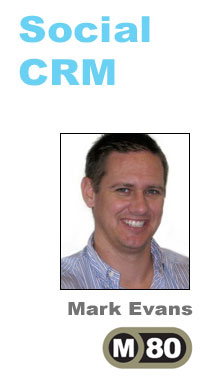 Social Customer Relationship Management – or Social CRM – has been increasingly on the minds of many marketers, their agents and ad tech companies as the use of social media proliferates and acquisitions of Vitrue by Oracle and Buddy Media by Salesforce signal a changing media landscape. Consumers are spending a large part of their “digital time” speaking with friends, giving the thumbs up or down to content and products and, in the process, unleashing yet another torrent of data that can be used to optimize the communication between consumers and brands. And offshoots of social data’s influence include new paid media concepts such as “native advertising.”
Social Customer Relationship Management – or Social CRM – has been increasingly on the minds of many marketers, their agents and ad tech companies as the use of social media proliferates and acquisitions of Vitrue by Oracle and Buddy Media by Salesforce signal a changing media landscape. Consumers are spending a large part of their “digital time” speaking with friends, giving the thumbs up or down to content and products and, in the process, unleashing yet another torrent of data that can be used to optimize the communication between consumers and brands. And offshoots of social data’s influence include new paid media concepts such as “native advertising.”
AdExchanger discussed the social CRM trend with Mark Evans who is managing director at M80 and Mindshare‘s social media practice.
AdExchanger: Social CRM – is this a new concept?
MARK EVANS: Social CRM has been around for almost a couple of years along with this notion about the “social customer” – a consumer that is learning about products or news through social avenues, whether it’s Twitter, Facebook, blogs and so on. The social customer is learning about products on these channels and expecting brands to engage and hear what they have to say.
In turn, this has challenged brands to rethink how their organizations are run, create product and engage with a customer. Loyalty has become a huge part of demonstrating how good a product works.
“Once you’ve tried my product, certainly talk about it in the social space, so that other people are seeing that, too.” – this has become a very key part of the relationship now, in this emerging area for brands.
What is the social data part of social CRM? What is it that is being collected?
Social CRM, itself, means different things to different companies. In the most simplest form, many brands want to understand what users like or don’t like around experiences with their brand.
Or maybe brands take data from call center or social listening tools in order to see what types of conversations are happening in the social space, and what type of platforms they’re happening on.
When you think about brands that understand how to do CRM in this much more contemporary light, it is about being able to take data from multiple sources, house it in one central area, and understand and be able to utilize that.
It’s about multiple avenues of data – not just the web.
Is social CRM suddenly hitting its stride with recent acquisitions – Salesforce/Buddy Media, Oracle/Vitrue? Where is it heading?
It’s building toward a command center approach of being able to have tools that are multi‑faceted, and allow you to be able to build a smarter, one‑to‑one relationship with your audience. Those acquirers you mentioned are continuing to round out and hone their offering, so that they can be even smarter tool for interpreting data, or helping interpret data and marketing, via the channels deemed appropriate for that audience.
Regarding the Paid‑Owned‑Earned media triangle, if you will, it feels like Earned is becoming much more important than it used to be in social marketing. Do you agree?
Paid definitely has a role. It’s important in terms of awareness and acquisition and will always be an important component of it. Earned allows you to extend a campaign. If you think about how campaigns used to work, in theory, there was a beginning and an end. Now we have timeless campaigns with content that’s evergreen, that lives on the web, where someone could uncover it while researching your brand a year after that campaign is over. And it’s pretty cool to be able to be in that situation.
At the end of the day, it’s about finding the recipe of the right content and the right manner to be able to deliver it, so that you can get people engaged and chatting with you, or conversing with you, and get them to engage with the next aspect of your [product] cycle.
Finally, is there an ideal type of client for a social CRM strategy?
No, it’s something that everyone should be thinking about. With social CRM, the customer is the focal point of how it operates. As I said earlier, instead of simply just pushing messages, it’s about working to collaborate with them and help either empower or solve customer challenges. It’s an evolved way of thinking, and brands should be moving themselves. For me, if I go out and I engage with Brand A, and they’re much more of a social business, I’m almost expecting that of the next brand that I work with.
You must think about the “water line” being raised by certain brands today. But with [Social CRM], brands need to do the appropriate homework by auditing their own internal processes and their own brands, in order to make sure they’re equipped to house appropriate data and respond to their audiences.
By John Ebbert
Follow Mark Evans (@etrain), m80 (@m80im) and AdExchanger (@adexchanger) on Twitter.













